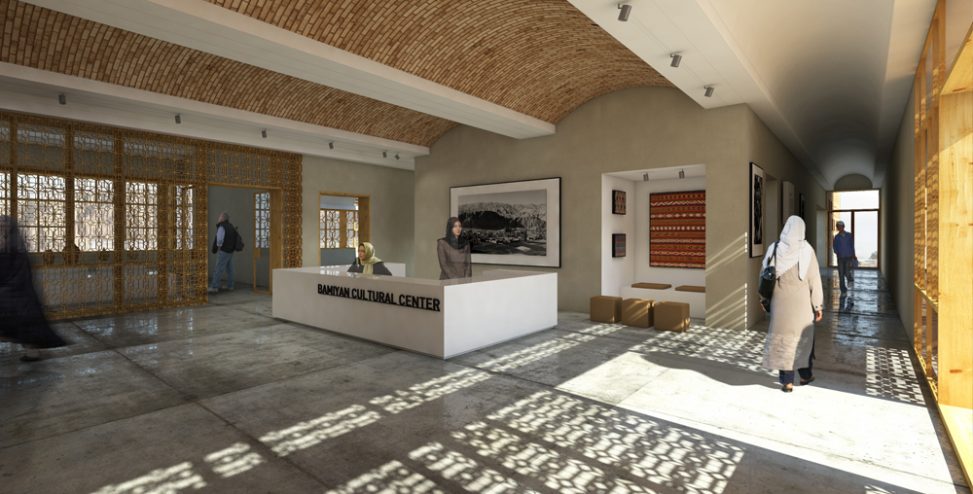A balance between visibility and discretion
Design Concept
The architecture of the Cultural Center draws its inspiration from Bamiyan natural landscape and from the pure shapes of its vernacular architecture. The Cultural Center sits in an environment that bears a strong identity, in a green valley surrounded by barren mountains covered with thousands of natural colors. It faces the outstanding cliff where the Bamiyan Buddhas once stood. The concept is based on a balance between visibility and discretion: the Cultural Center must be clearly identifiable as a cultural facility; it should enhance the site and the community, while being a humble part of this territory and its strong identity. We have therefore chosen to set the building on the highest platform of the land, on the edge of the cliff, where the ancient citadel stood. The volume of the Cultural Center is therefore clearly visible from the valley, like any construction of community importance. However, its shape is simple and the building materials used are sourced on site to ensure a clear integration into the landscape.
Our expertise in earthen architecture and our knowledge of Bamiyan (thanks to missions done in 2014) incites us to make use of local construction techniques: cob, adobe bricks and earth-straw plasters. These techniques are currently very well mastered in the valley and remain totally relevant in terms of sustainable architecture. Using these techniques for a contemporary building is a way to revitalize local know-how, pay tribute to local skills and minimize the use of imported resources.
We also suggest to deal with the issues of energy and water management right from the design stage. The proposed building allows the installation of solar panels for electricity production and allows water collection and recycling to keep the landscape green. In terms of thermal control, the project makes extensive use of thick walls with high inertia to limit temperature fluctuations, and optimizes passive solar gains.
Lanscape Design
Access to the site is from the upper part of the plot. After crossing the boundary wall through a large security gate, and after parking the vehicles along the wall, access to the building is done by foot through a square. It is fitted with benches placed in the shade of local trees such as poplars and fruit trees. Building on the highest part of the plot frees the lower part where we suggest creating an open landscaped park accessible to all. It is equipped to accommodate outdoor cultural events, always in conjunction with the landscape of Bamiyan Valley.
Master Plan and Construction Grid
The Cultural Center has only one level for easy access and distribution in the building. Depending on the needs of the program, we play with ceiling heights to enrich the interior spaces and create different patterns on the facades. The developed linear grid is compatible with the construction of vaults which create fluid and continuous spaces in which elements of the program and circulations will naturally take place. It also allows flexibility of uses and possible évolutions. The reception, placed in the centre, distributes areas accessible to the public but also private work spaces. The corridors lead to rooms and patios and converge all to the reception.
Natural light is everywhere, mostly filtered from the roof to favor neutral and indirect lighting of spaces. However to the south small niches in the external walls filter solar gain while allowing vistas from inside. The northern walls are more open with wide openings framing the cliffs and the Buddha niches. A set of filters made of wooden elements reproduce a traditional Hazara textile motif, creating a dynamic rhythm on the facades but also on the interior lighting effects. The pace of niches on the facades is a nod to the Buddhas niches on the cliff and a tribute to the cave dwellings on the other side of the valley.
Building Materials
It is fundamental for us to value the local expertise and local building materials by using them in a large public building, dedicated to culture, with a contemporary language yet sober and understandable to all, with untransformed raw materials taken from the site. The technique of vaults and domes can be explained to craftsmen on site with the long term goal of limiting the use of timber and concrete in construction. This building technique also has the advantage of being economically sustainable, because it does not depend on the hazards of delivery and it is easy to maintain.
• Cob (Pakhsa): by nature with its thick monolithic walls, cob meets the thermal and structural requirements necessary for the construction of the Cultural Center. It is omnipresent in the landscape and the knowledge is still well mastered. Cob walls are 60 cm thick at the bottom and can rise up to 8 m in height. Unlike rammed earth, cob walls do not require reinforced shuttering, which cannot be found in Bamiyan.
• Adobe: also very present locally, adobe bricks are used in the project to span large spaces with vaults. Vaults replace wooden beams which are often used locally to roof small domestic spaces. The adobe bricks will be produced on site.
• Wood: Wood will be limited to finishing work, for joinery and light filters.
• Natural fiber : mixed with mud mortar will be use for roof insulation on top of vaults, under the waterproof plaster.
• Few imported materials: a small amount of cement and steel will be needed for the foundations and to provide seismic reinforcement. Horizontal and vertical reinforced concrete beams will secure the building in the event of an earthquake. They will also serve to hold the horizontal thrusts of the vaults.
From a technical point of view, the building will be equipped with flexible solar panels, amorphous or crystalline, which follow the curve of the vaults over the waterproof roof membrane. This contribution will increase the autonomy of the building in terms of energy. All rainwaters falling on the roof or on the ground will be collected and recycled for watering the gardens.

